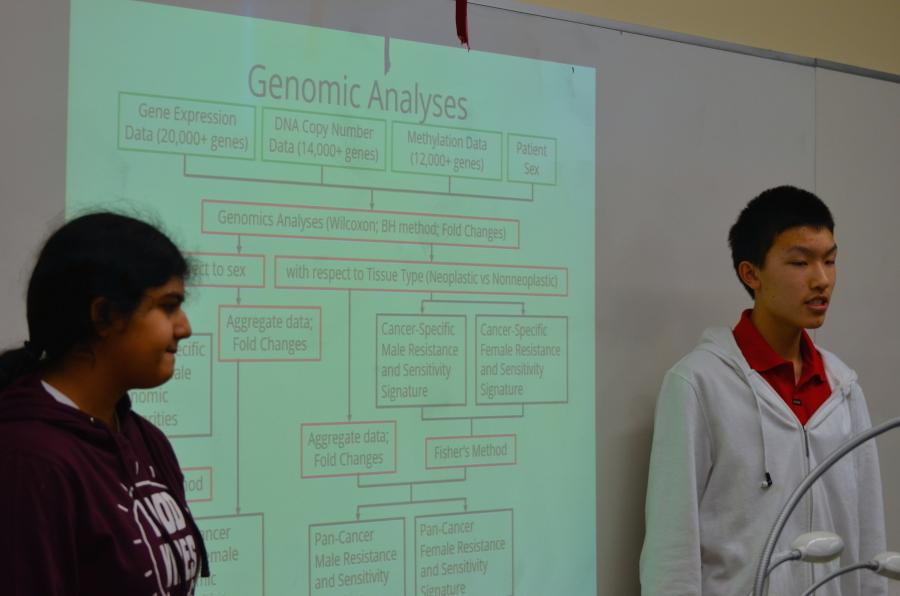Siemens Finalists present project during long lunch last week
The Siemens Competition finalists Sadhika Malladi (11) and Jonathan Ma (11) utilized a Power Point to present their experiment. Before presenting to the judges, they practiced in front of Upper School science teachers.
During long lunch last week, the Siemens Competition finalists Sadhika Malladi (11) and Jonathan Ma (11) presented their project.
In their theoretical and computational experiment, they compared the success of seventeen different cancer treatments in males versus females.
“One of the goals of our experiment was to perform analyses across multiple cancers, not just one,” Jonathan said. “We found that while a lot of drugs are equally potent in both sexes, there’s also many other drugs that are effective in one sex but not the other.”
Out of 1,784 entries for the Siemens Competition, their research was selected this October to be one of 10 regional finalist projects. They won a $1000 prize.
The two juniors received guidance from Mike Pistacchi and Anita Chetty. They started their research over the summer after a National Institute of Health article sparked their interest.
“[The article] was talking about how the NIH was trying to address the sex bias in science by requiring that proposals include the number of specimens of each sex that are going to be used in the experiment,” Sadhika said. “Earlier, women were completely underrepresented in clinical trials.” For instance, according to Sadhika, only 37 percent of trial participants in nine major medical journals are female.
Even though their project was purely computational and theoretical, Sadhika and Jonathan found that their predictions matched several other studies’ results. In their presentation, they showed a graph of the potency of cancer treatments for males compared to females.
“For example, tamoxifen is an estrogen inhibitor and we predicted that it would be more effective in females than in males in this type of lung cancer called lung adenocarcinoma,” Jonathan said. “This agrees with a prior study that found that this was the case.”
As for future implications of their project, Sadhika and Jonathan want to test their findings on live tissues.
“We would want to try to validate our theoretical predictions with live tissue experiments, and we also want to find differences in other demographics, like between ethnicities,” Sadhika said.
Other students besides Sadhika and Jonathan entered the Siemens competition, but they did not present. Vineet Kosaraju (11) and Jason Chu (12) were both regional finalists, but they did not present today.
More information on the Siemens Competition at http://www.siemens-foundation.org/en/.
Melissa Kwan is a junior and the Seniors Editor for TALON Yearbook. This is Melissa's third year on staff. In her free time, Melissa plays volleyball for...


















![“[Building nerf blasters] became this outlet of creativity for me that hasn't been matched by anything else. The process [of] making a build complete to your desire is such a painstakingly difficult process, but I've had to learn from [the skills needed from] soldering to proper painting. There's so many different options for everything, if you think about it, it exists. The best part is [that] if it doesn't exist, you can build it yourself," Ishaan Parate said.](https://harkeraquila.com/wp-content/uploads/2022/08/DSC_8149-900x604.jpg)




![“When I came into high school, I was ready to be a follower. But DECA was a game changer for me. It helped me overcome my fear of public speaking, and it's played such a major role in who I've become today. To be able to successfully lead a chapter of 150 students, an officer team and be one of the upperclassmen I once really admired is something I'm [really] proud of,” Anvitha Tummala ('21) said.](https://harkeraquila.com/wp-content/uploads/2021/07/Screen-Shot-2021-07-25-at-9.50.05-AM-900x594.png)







![“I think getting up in the morning and having a sense of purpose [is exciting]. I think without a certain amount of drive, life is kind of obsolete and mundane, and I think having that every single day is what makes each day unique and kind of makes life exciting,” Neymika Jain (12) said.](https://harkeraquila.com/wp-content/uploads/2017/06/Screen-Shot-2017-06-03-at-4.54.16-PM.png)








![“My slogan is ‘slow feet, don’t eat, and I’m hungry.’ You need to run fast to get where you are–you aren't going to get those championships if you aren't fast,” Angel Cervantes (12) said. “I want to do well in school on my tests and in track and win championships for my team. I live by that, [and] I can do that anywhere: in the classroom or on the field.”](https://harkeraquila.com/wp-content/uploads/2018/06/DSC5146-900x601.jpg)
![“[Volleyball has] taught me how to fall correctly, and another thing it taught is that you don’t have to be the best at something to be good at it. If you just hit the ball in a smart way, then it still scores points and you’re good at it. You could be a background player and still make a much bigger impact on the team than you would think,” Anya Gert (’20) said.](https://harkeraquila.com/wp-content/uploads/2020/06/AnnaGert_JinTuan_HoHPhotoEdited-600x900.jpeg)

![“I'm not nearly there yet, but [my confidence has] definitely been getting better since I was pretty shy and timid coming into Harker my freshman year. I know that there's a lot of people that are really confident in what they do, and I really admire them. Everyone's so driven and that has really pushed me to kind of try to find my own place in high school and be more confident,” Alyssa Huang (’20) said.](https://harkeraquila.com/wp-content/uploads/2020/06/AlyssaHuang_EmilyChen_HoHPhoto-900x749.jpeg)



